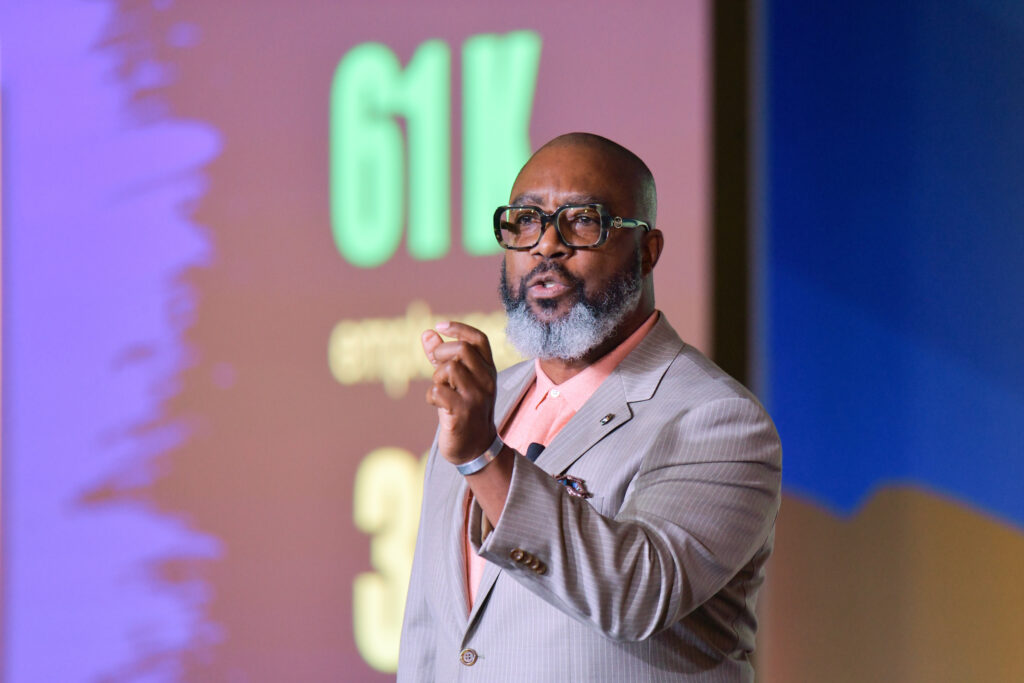
A Reflection of D&I in the Workforce
When Torin Ellis Corporate Diversity Strategist, Consultant and Coach, began speaking with the audience during the Impact! Talks, at the 2022 Executive Summit, it was a moment to reflect on strategies, commitment, and truth to achieving the DEI (Diversity, Equity, and Inclusion) goals that many organizations claim as a priority.
It turns out, there is still much to be done in our work world and Ellis challenged leaders to look at the way they do things differently.
An unwavering commitment to D&I
Ellis shared that to make a difference, it might mean having uncomfortable conversations aimed at peeling away the obstacles blocking true diversity, equity, and inclusion in today’s workforces. We start by:
- Rethinking the idea of people analytics
- Establishing high expectations and trust
- Recognizing and eliminating inhibitors to achieve DEI goals
To illustrate the significance of a higher level of commitment, he shared some context:
- In 2015, tech giant Google had a workforce of 61,000 employees – with only 3% diversity.
- Ellis noted if the organization was going to be honest in evaluating the reports and truly make a difference, they had to fire half of their then workforce and rehire individuals from under-represented and under-resourced communities.
- This meant establishing new relationships with academic institutions, revealing target audiences in social media—having a different connection with the community.
- In 2020, Google had grown to 135,301 employees… with 4% diversity.
The lack of change wasn’t for lack of desire to make that change; it’s that organizations continue to think that “we can achieve a different result if we continue to do it the way that we have always done it,” said Ellis.
Changing the way, it’s always been done
According to Ellis, leaders must take a truthful look at their actions and the strategies in place if they are going to evolve the workforce.
“How far do we want to go with this D&I thing?” as Ellis notes:
- Will we overhaul and redesign our organizations?
- Will we continue to evaluate our HR data the same way so that we can claim “plausible deniability,” or will we force ourselves to look through a different lens?
- Will we change operational protocols and hold people accountable?
- Is Leadership willing to reallocate resources – headcount and dollars – discounting the excuses of ‘I just want to hire the best talent’ or ‘there’s no talent in the pipeline”?
- Are we going to put ourselves in different rooms, with different communities, as we build our brands or are we going to be safe with ‘I just want to hire the best talent’?
Ellis encourages us to hold Lee Jourdan, the former Chief Diversity Officer of Chevron, as an example of changing the way we do things. Mr. Jourdan reimagined D&I for the energy giant. Despite his vast success, he was forever watching organizations hit the wall in their D&I efforts. A source of frustration that continues in today’s Corporate America, Jourdan continues providing guidance to leaders on making an impact through measurable diversity goals, and to think and act differently in order to achieve them.
ROI of D&I is greater humanity
To push the needle for DE&I, our storytelling must be more transparent, Ellis notes. “Recruiters are on the front line,” he says, “the vanguard of building high performing teams and profitable organizations. It is high time we do a far better job of telling stories,” along with being focused on ‘Accountability…Not Fairy Dust.’
The landscape, he tells us, shows organizations will “drop a press release, engage in a myriad of train-wreck training, or the million-dollar pledges.” Following the George Floyd tragedy in the summer of 2020, according to Ellis, organizations poured in commitments surrounding D&I, social justice, and racial initiatives to the tune of $58 billion. As of June 2021, 0.5% of that money had been realized. Are we holding people accountable? he asks.
If we are, then we would:
- Do a better job of codifying strategies inside of our day-to-day processes.
- Identify, inspire, resource and support individuals on our teams so they are no longer a flight risk.
- Neutralize the threats to D&I and the value points in our organizations by being intentional. You can no longer just say it.
In closing, Torin Ellis notes “D&I is not punitive, but it is uncomfortable.” And in terms of race, work, and leadership, we have to experience “a shift in openness and value given to the narrative by both the storyteller and the listener.”
We have to be intentional in order to be better.
WEBINAR: To learn more about Gender Equity Progress in the Staffing Industry, read key findings from the WBC second benchmark survey and explore how staffing professionals can continue to elevate and support women in the industry.
Moderator: Kip Wright, Chairman & CEO, INSPYR Solutions
Panelists:
– Sunny Ackerman, President | Americas, SThree
- Threase Baker, President, ABBTECH Professional Resources, Inc.
– Denise Dettingmeijer, Chief Financial Officer, Randstad North AmericaThis webinar is a joint presentation hosted by the leading organizations representing the staffing industry and will be sharing survey results collected from members of the American Staffing Association, National Association of Personnel Services, Staffing Industry Analysts, and TechServe Alliance.


